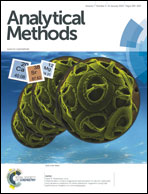A novel fluorescent sensor for mercury (ii) ion using self-assembly of poly(diallyl dimethyl ammonium)chloride functionalized CdTe quantum dots
Abstract
Poly(diallyl dimethyl ammonium)chloride (PDDA) functionalized CdTe quantum dots (QDs) (PDDA–CdTe QDs) were synthesized through electrostatic self-assembly and used as fluorescence sensors. Mercury(II) ion (Hg2+) has a dramatic fluorescence quenching effect on the PDDA–CdTe QDs. Based on this quenching effect, a very sensitive fluorescence sensor for Hg2+ detection was established. Under the optimum conditions, the fluorescence quenching effect of PDDA–CdTe QDs was linear with the concentration of Hg2+ in the range from 0.006 μmol L−1 to 1.0 μmol L−1. The detection limit was calculated as 5.0 nmol L−1 according to the 3σ IUPAC criteria. This PDDA–CdTe QDs sensor system represents a new feasible method to improve the spectroscopic characterization of QDs used as Hg2+ sensors.


 Please wait while we load your content...
Please wait while we load your content...